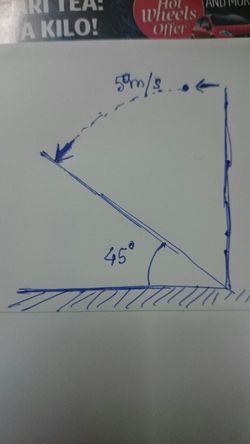An Original Projectile
 A ball is thrown horizontally from top of a tall tower at 50 m/s. The ground below is a uniform slope upwards of 45 degrees. The direction of the ball when it hits the slope is exactly perpendicular to the slope.
A ball is thrown horizontally from top of a tall tower at 50 m/s. The ground below is a uniform slope upwards of 45 degrees. The direction of the ball when it hits the slope is exactly perpendicular to the slope.
After how many seconds did the ball hit the ground ?
Take g = 9.8 m/s^2
The answer is 5.102.
This section requires Javascript.
You are seeing this because something didn't load right. We suggest you, (a) try
refreshing the page, (b) enabling javascript if it is disabled on your browser and,
finally, (c)
loading the
non-javascript version of this page
. We're sorry about the hassle.
4 solutions
For a projectile projected horizontally from an elevation, the angle it makes with the horizontal at any time t is given as
tan β = u g t
where u =initial velocity
The projectile strikes the slope at 9 0 ∘ which implies it makes an angle of 4 5 ∘ with the horizontal. Substituting the values to the above equation,
t = 5 . 1 0 2 s
really, how come horizontal velocity is 50, thats 45 degrees to the plane, and 50 sin45 will give u horizontal component and 50 cos45 will give u the vertical component, could u pls clarify my doubt
Drat! Would have got that right had I used the right formula! Used v=ut+1/2at^2 for some reason
Log in to reply
distance travelled is given by that formula
Log in to reply
Yep. Knew I needed to find out how long it took to hit 5m/s vertically, but I'm rusty on the various acceleration formulas. Should have looked one up.
90 perpendicular... gives.. velcocity in x direction=velocity in y direction as no force on x axis.. velocity in x= 50 constant , but velocity in y is increasing by v=u+at, here u=0, as the ball is thrown horizantly, this gives v in y =at which is further =50 now.... 9.8 X T = 50, T=5.102
It is quite easy,but i dont know maybe because i do this at 2 AM,i need 15 minutes hahaha,SO.....it happened when tan 45:Vy/Vx,in another word when Vy=Vx, Vy=0-gt -50=-gt 80=(9.8)t t:5.102
since the velocity of the ball when it strikes the ground is perpendicular to the ground, i.e. it is 45 degrees wrt horizontal, since tan 45 =1, the horizontal and vertical velocites are equal. initiial horizontal veolcity remains unchanged (=50m/s) therefore we need to find time for vertical velocity to become 50 m/s. v=u+at 50=0+10(t) t=5s.
The net resultant velocity of the ball at any instant is a vector sum of the horizontal and vertical velocities at that time.
Since it is given that ball velocity at time of impact is directed 45 degrees down from the horizontal, the vertical velocity at that instant is the same as the horizontal viz 50 m/s.
v = u + at
t = 5.102 s